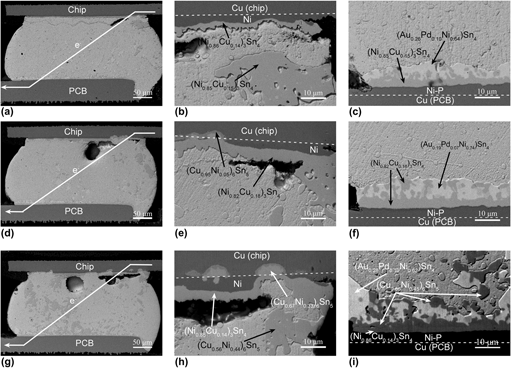Crossref Citations
This article has been cited by the following publications. This list is generated based on data provided by
Crossref.
Huang, Mingliang
Zhou, Qiang
Ma, Haitao
and
Zhao, Jie
2013.
Effect of liquid-solid electromigration on interfacial reaction in Cu/Sn-9Zn/Cu solder joint.
p.
1090.
Huang, M. L.
Zhou, Q.
Zhao, N.
and
Zhang, Z. J.
2013.
Abnormal Diffusion Behavior of Zn in Cu/Sn-9 wt.%Zn/Cu Interconnects During Liquid–Solid Electromigration.
Journal of Electronic Materials,
Vol. 42,
Issue. 10,
p.
2975.
Huang, M.L.
Zhang, Z.J.
Zhao, N.
and
Zhou, Q.
2013.
A synchrotron radiation real-time in situ imaging study on the reverse polarity effect in Cu/Sn–9Zn/Cu interconnect during liquid–solid electromigration.
Scripta Materialia,
Vol. 68,
Issue. 11,
p.
853.
Meinshausen, L.
Frémont, H.
Weide-Zaage, K.
and
Plano, B.
2013.
Electro- and thermomigration-induced IMC formation in SnAg3.0Cu0.5 solder joints on nickel gold pads.
Microelectronics Reliability,
Vol. 53,
Issue. 9-11,
p.
1575.
Huang, Mingliang
Zhang, Zhijie
Zhou, Shaoming
and
Chen, Leida
2014.
Stress relaxation and failure behavior of Sn–3.0Ag–0.5Cu flip-chip solder bumps undergoing electromigration.
Journal of Materials Research,
Vol. 29,
Issue. 21,
p.
2556.
Huang, M. L.
Zhou, Q.
Zhao, N.
Liu, X. Y.
and
Zhang, Z. J.
2014.
Reverse polarity effect and cross-solder interaction in Cu/Sn–9Zn/Ni interconnect during liquid–solid electromigration.
Journal of Materials Science,
Vol. 49,
Issue. 4,
p.
1755.
Huang, M.L.
Zhang, Z.J.
Ma, H.T.
and
Chen, L.D.
2014.
Different Diffusion Behavior of Cu and Ni Undergoing Liquid–solid Electromigration.
Journal of Materials Science & Technology,
Vol. 30,
Issue. 12,
p.
1235.
Hu, Xiao
and
Chan, Y.C.
2014.
Reinforced solder joint performance by incorporation of ZrO2 nanoparticles in electroless Ni–P composite layer.
Journal of Materials Research,
Vol. 29,
Issue. 22,
p.
2657.
Huang, M. L.
and
Zhao, N.
2015.
Effect of Electromigration on the Type of Drop Failure of Sn–3.0Ag–0.5Cu Solder Joints in PBGA Packages.
Journal of Electronic Materials,
Vol. 44,
Issue. 10,
p.
3927.
Zhao, Ning
Zhong, Yi
Huang, Mingliang
and
Ma, Haitao
2015.
Interfacial reactions in Cu/Sn/Cu(Ni) systems during soldering under temperature gradient.
p.
1263.
Gorywoda, Marek
Dohle, Rainer
Kandler, Bernd
and
Burger, Bernd
2015.
Study on electromigration in flip chip lead-free solder connections with 40 μm or 30 μm diameter on thin film ceramic substrates.
International Symposium on Microelectronics,
Vol. 2015,
Issue. 1,
p.
000799.
Gorywoda, Marek
Dohle, Rainer
Wirth, Andreas
Burger, Bernd
and
Gossler, Jorg
2015.
On the failure mechanism in lead-free flip-chip interconnects comprising ENIG finish during electromigration.
p.
2030.
Huang, M. L.
Zhang, F.
Yang, F.
and
Zhao, N.
2015.
Size effect on tensile properties of Cu/Sn–9Zn/Cu solder interconnects under aging and current stressing.
Journal of Materials Science: Materials in Electronics,
Vol. 26,
Issue. 4,
p.
2278.
Qiu, Yan
Huang, Mingliang
and
Wu, Aimin
2016.
Study on the electromigration-induced failure mechanism of Sn-3.0Ag-0.5Cu BGA solder balls.
p.
524.
Lin, T. C.
Kung, H. Y.
Lee, S. H.
Chen, M. H.
Chiu, Y. T.
and
Lin, K. L.
2018.
The failure mode of Bi and Ni-doped Sn-Ag-Cu solder joint under electromigration tests.
p.
226.
Lin, Y.S.
Kung, H.Y.
Lee, S.H.
Chen, M.H.
Lin, T.C.
and
Kao, C.L.
2018.
Electromigration Lifetime Improvement of WLCSP by Using Different Structure of UBM.
p.
15.
Dai, Junjie
Zhang, Yuexin
Li, Zhankun
Chen, Mingming
Guo, Yuhua
Fan, Zhekun
and
Li, Junhui
2022.
Research on Reliability of Ni/Sn/Cu(Ni) Copper Pillar Bump Under Thermoelectric Loading.
Journal of Electronic Packaging,
Vol. 144,
Issue. 3,
Wang, Shengbo
Ren, Jing
Huang, Feifei
and
Huang, Mingliang
2024.
Electromigration-Induced Failure of Low-Temperature Sn-57Bi-1Ag Solder Interconnect Under Low Frequency Pulsed Direct Current Stressing.
p.
1.
Chen, J. L.
Wang, S. B.
Ren, J.
and
Huang, M. L.
2024.
Effect of Annealing Treatment on Electromigration Resistance of Low-Temperature Sn-57Bi-1Ag Solder Interconnect.
Journal of Electronic Materials,
Vol. 53,
Issue. 11,
p.
7065.
